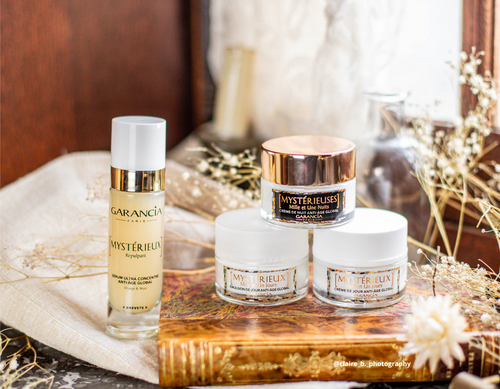- Why should you protect your skin from the sun?
- How to choose your sun protection?
- How to take care of your skin in the sun?
- Taking care of your skin before and after sun exposure
- Our advice for protecting yourself from the sun
- What products can you discover to protect your skin from the sun at Garancia?
The sun is the main cause of skin aging, and it is often the cause of the appearance of pigment spots. Find out how to protect your skin from UV rays.
Why should you protect your skin from the sun?
Ultraviolet (UV) rays emitted by the sun are classified into three categories: UVA, UVB and UVC. These rays are well known for their harmful effects on health. However, it is important to note that blue lights, present in the visible light spectrum, are even more harmful than UV rays.
There are two types of blue light, mainly coming from the sun's rays. On the one hand, "turquoise blue" light, which is vital to the body since it contributes to our awakening, our falling asleep and our well-being in general.
On the other hand, blue-violet light is more harmful because it accelerates the aging of our cells. In addition, this light, which is partly filtered by the lens, penetrates deep into the eye and hits the retina on its central part, which ultimately increases the risk of macular degeneration.
Ultraviolet rays are classified into 3 categories:
- UVA (ultraviolet A), which represents 95% of the sun's rays. These rays penetrate deep into the skin, making them difficult to block, and not only are they the cause of its aging, but they can cause certain skin cancers;
- UVB (ultraviolet B). More powerful than UVA, these rays are responsible for your sunburn, which means they burn your skin. However, since they are blocked by glass and clouds, only 10% of them reach the deeper layers of the skin;
- UVC (ultraviolet C), which is completely filtered by the ozone layer.
Skin aging and allergies
When you don't protect your skin from the sun, UV rays accelerate your skin aging. Indeed, by penetrating into the deeper layers of the skin, the sun's rays destroy collagen and elastic fibers, which leads to sagging of your skin as well as the appearance of furrows and wrinkles. In addition, small brown spots accompanied by areas of depigmentation appear.
Reactions can also occur following prolonged exposure to UV rays, particularly when this exposure is combined with certain medications or cosmetic products.
Sunburn
Caused by UVB rays, sunburn is the most well-known reaction to the sun. These skin burns correspond to the destruction of thousands of cells in the epidermis and can cause more or less painful redness, with itching and sometimes accompanied by blisters. In the most serious cases, healing can take some time and leave scars.
Skin cancers
The sun causes two types of skin cancer:- Cutaneous melanoma. This type of cancer is uncommon, and its occurrence is promoted by the sun's ultraviolet rays. Frequent sunburn (especially during childhood), prolonged exposure to the sun, a long stay in a very sunny country as well as working outdoors increase the risk of developing melanoma;
- A carcinoma, which is the most common skin cancer. This type of cancer develops locally and is promoted by excessive and repeated exposure to the sun.
How to choose your sun protection?
The first criteria to take into consideration when choosing your sun protection are your skin type and the exposure conditions, i.e. the duration and power of the solar radiation.
A sunscreen product contains two so-called photoprotective filters:
- Chemical filters, also called organic filters, which absorb UVA and UVB;
- Mineral screens that reflect UV rays.
Beyond protection against UVB and UVA, a sunscreen product must meet a certain number of standards:
- A Sun Protection Factor (SPF) of at least 6. There are 8 indices grouped into 4 levels of protection: 6 to 10 is equivalent to low protection, 15 to 25 to medium protection, 30 to 50 to high protection and 50+ to very high protection;
- UVA protection equivalent to 1/3 of the SPF, at least.
Which sunscreen should you choose for your face?
Today, there are sunscreen creams suitable for all skin types:
- You have oily, acne-prone skin: a light, fluid and mattifying cream with an SPF 50 index is recommended;
- Your skin is prone to hyperpigmentation: choose an anti-spot sunscreen to effectively protect existing brown spots and prevent new ones from appearing;
- You have dry skin: a moisturizing formula, suitable for thin and sensitive facial skin, is ideal.
How to take care of your skin in the sun?
A few weeks before your sun exposure, you can prepare your skin by taking nutritional supplements that contain antioxidant active ingredients. In this way, you can strengthen your skin's internal protection against the sun, which is particularly recommended if your skin is particularly sensitive to the sun. However, these supplements do not protect the skin and they cannot replace external sun protection in the event of exposure.
Self-tanners artificially color the skin, but do not offer any protection, as they do not stimulate melanin production. Therefore, when using self-tanner, it is essential to apply a photoprotector as soon as you expose yourself to the sun.
Apply a sunscreen product suitable for the sun and your skin type, preferably 20 minutes before exposure so that the skin is well absorbed by the product.
Also, remember that sunscreen should be renewed at least every 2 hours and systematically after each swim. Indeed, a so-called “water-resistant” cream does not lose more than 50% of its protective power after a swim, but it is still less effective against the sun's rays.
Also remember to check the expiry date of your sunscreen products and renew them every year as indicated on the instructions, because their protective power is no longer guaranteed.
Taking care of your skin before and after sun exposure
If you are sensitive to the sun or suffer from sun allergies, oral sun food supplements help prepare you for sun exposure, so you can start taking them 2 to 3 weeks in advance, to minimize the allergenic effects of the sun. These products can also be consumed after returning from vacation, to avoid premature skin aging linked to the sun.
After exposure, it is essential to nourish your skin which has been damaged and dried out by the sun. You can use a milk, an after-sun lotion or a product that contains carrot vegetable oil. The latter not only helps maintain the tan, but also moisturizes the upper layers of the skin.
Our advice for protecting yourself from the sun
In general, try to avoid exposure when the sun's rays are at their most intense as much as possible. This phase corresponds to the time when the sun is high in the sky (between 11 a.m. and 4 p.m. in summer in particular).
If you plan to stay on the beach all day, bring sunglasses with a high UV protection factor, a wide-brimmed hat and loose-fitting clothing.
Also, don't trust your impressions, because it is quite possible to get sunburned without having the feeling of exposing yourself unnecessarily. In fact, it is infrared rays that cause the sensation of heat and not UV rays. Thus, an overcast sky in summer can be misleading!
If you are planning a mountain holiday, be aware that the danger exists even when temperatures are very low, because the shield formed by the atmosphere is reduced due to altitude and the reflection on the snow considerably increases the ultraviolet radiation reaching the skin. Thus, the sun is more aggressive in the mountains than on the beach, even in winter.
Always prefer shade to sun, but be aware that it does not provide impenetrable protection, since it does not protect against solar radiation reflected by the ground or against solar radiation diffused by particles suspended in the atmosphere.
What products can you discover to protect your skin from the sun at Garancia?
At Laboratoire Garancia, we offer sunscreen products that protect the whole family, while better respecting the oceans. In order to face the sun's rays this summer, we particularly recommend the use of the following products.
The invisible fluid with very high protection
The Incredible Softness Invisible Sun Protect Fluid SPF50+ has a dual anti-aging and anti-spot action: thanks to its unique broad-spectrum combination of 4 organic UV filters, anti-blue light plant protectors (2 red algae extracts + pongamia) and hyaluronic acid helps fight against skin aging and the appearance of spots. Ideal as a makeup base, thanks to this product your skin is protected, smoothed, plumped and incredibly soft.
Metamorphosing solar waters
To adapt to all phototypes, the metamorphosing waters from Laboratoire Garancia are available in 2 different protection indices:
- Red Sun Protect Métamorphosante Solar Water SPF30 protects you while accelerating your tan; suitable for dark or already tanned skin
- Sun Protect Metamorphosing Protective Solar Water SPF50+ offers very high protection and antioxidant action.
Photo credit: @cassandra_polito

![Laboratoire Garancia Soin de la peau [ FLUIDE INCROYABLE DOUCEUR INVISIBLE SUN PROTECT ] SPF50+](http://garancia-beauty.com/cdn/shop/files/FONDTRANSPARENTcopie.webp?v=1711012172&width=800)
![Laboratoire Garancia Soin de la peau [ FLUIDE INCROYABLE DOUCEUR INVISIBLE SUN PROTECT ] SPF50+ first-img](http://garancia-beauty.com/cdn/shop/files/PRESENTATION_SOLAIRE_FLUIDE_BIScopie.webp?v=1711012172&width=800)
![Laboratoire Garancia Soin de la peau [ L'EAU Solaire Rouge Métamorphosante SUN PROTECT ] SPF30](http://garancia-beauty.com/cdn/shop/files/FONDTRANSPARENTcopie_0587f5e3-401c-4d83-a25d-e1e5b7842c33.png?v=1711036759&width=800)
![first-img Laboratoire Garancia Soin de la peau [ L'EAU Solaire Rouge Métamorphosante SUN PROTECT ] SPF30](http://garancia-beauty.com/cdn/shop/files/PRESENTATION_SOLAIREcopie.jpg?v=1711036689&width=800)
![[ Lait Solaire Douceur Invisible SUN PROTECT ] SPF50+](http://garancia-beauty.com/cdn/shop/files/Design-sans-titre-_50.webp?v=1728984584&width=800)
![first-img Laboratoire Garancia Soin de la peau [ Lait Solaire Douceur Invisible SUN PROTECT ] SPF50+ first-img](http://garancia-beauty.com/cdn/shop/files/PRESENTATION_SOLAIRE_LAITcopie.webp?v=1711013358&width=800)
![Laboratoire Garancia Soin de la peau [ BRUME LACTÉE FRAICHEUR EXPRESS SUN REPAIR ]](http://garancia-beauty.com/cdn/shop/files/FONDTRANSPARENT_BRUME_974bca02-26c6-46ec-9ab2-ef2f96de4e01.png?v=1718613185&width=800)
![first-img Laboratoire Garancia Soin de la peau [ BRUME LACTÉE FRAICHEUR EXPRESS SUN REPAIR ]](http://garancia-beauty.com/cdn/shop/files/PRESENTATION_SOLAIRE_BRUMEcopie_1.jpg?v=1718613129&width=800)


